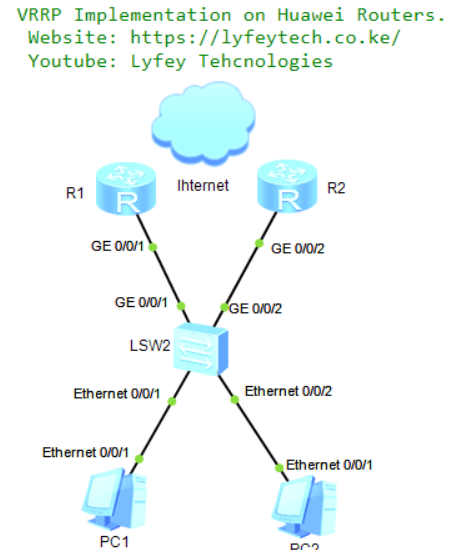VRRP Implementation on Huawei Routers.
- December 8, 2024
- Posted by: James Majani
- Categories: Huawei, Networking
404 Comments

VRRP basic concepts.
- VRRP groups several routers into a virtual router. If one of routers fails, traffic can be switched to another router, ensuring service continuity and reliability.
- VRRP router: A router running VRRP, such as R1 and R2. VRRP is configured on interfaces of routers and works based on interfaces. Each VRRP group forms a virtual router that is a logical device. A VRRP group forms only one virtual router.
- Virtual router ID (VRID): A VRRP group consists of multiple routers (interfaces) that work together and are identified by the same VRID. Routers in the same VRRP group exchange VRRP packets and form a virtual router. Only one master router can exist in a VRRP group.
- Virtual IP address and virtual MAC address: A virtual router has its own IP address and MAC address. The IP address is specified by the network administrator during VRRP configuration. A virtual router can have one or more IP addresses. Generally, this IP address is used as the gateway address. The format of the virtual MAC address is 0000-5e00-01xx, where xx is the VRID.
- VRRP defines two timers:
• ADVER_INTERVAL timer: specifies the interval at which the master router sends VRRP Advertisement packets. The default value is 1s.
• MASTER_ DOWN timer: indicates that the backup router preempts the Master state after the
MASTER_DOWN timer expires. The MASTER_DOWN timer is calculated as follows:
MASTER_DOWN = (3*ADVER_INTERVAL) + Skew time (offset time)
Skew_Time = (256 – Priority) /256
Networking description.
An enterprise LAN has two egress routers . Users are connected to access switches and access switches connect to the routers. Gateway of LAN services is on the routers. VRRP is implemented to enhance gateway reliability, multiple gateways are deployed to prevent a single point of failure.
Step 1: Configure the gateways.
*******************************************R1
system-view
sysname R1
#
interface GigabitEthernet0/0/1
ip address 192.168.10.253 255.255.255.0
vrrp vrid 1 virtual-ip 192.168.10.254
vrrp vrid 1 priority 200
vrrp vrid 1 preempt-mode timer delay 10
#
return
*******************************************R2
system-view
sysname R2
#
interface GigabitEthernet0/0/2
ip address 192.168.10.252 255.255.255.0
vrrp vrid 1 virtual-ip 192.168.10.254
vrrp vrid 1 priority 120
#
returnStep 2: Set gateway IP address of hosts to the floating gateway.

Step3: Result confirmation.


Execute a continuous ping to the gateway and shutdown one of the gateways. Expected result is there should be reachability since gateway reliability has been configured.
Leave a Reply
You must be logged in to post a comment.
